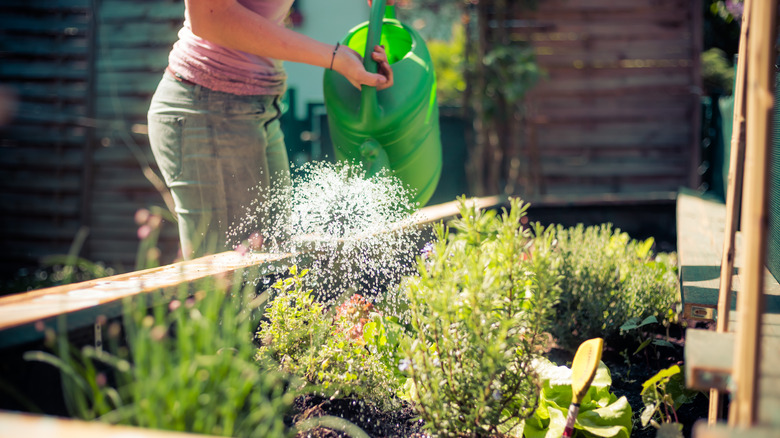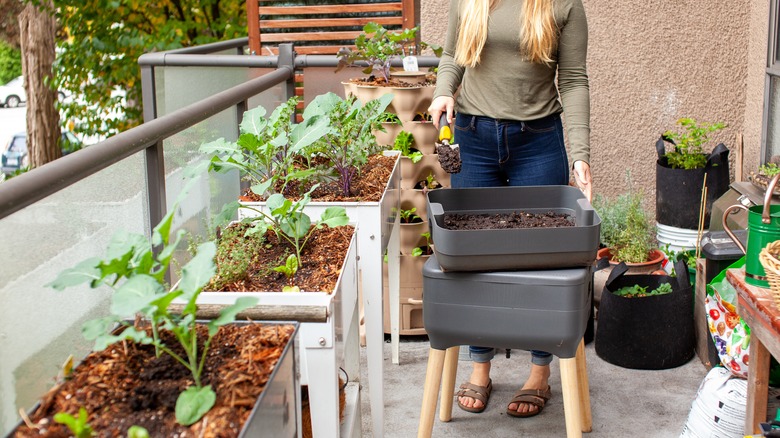Save Time And Water With TikTok's Ingenious Gardening Solution
Growing a garden offers multiple benefits: gorgeous curb appeal, fresh harvest, and reduced stress, whether you're an avid gardener or learning how to garden for the first time. Beginners can struggle with creating and maintaining a watering schedule for their plants, primarily if they work long hours and don't have the time to water them. While expert gardeners have a better handle on knowing when to water their plants, they can also fall behind when life gets busy. When plants don't receive their required water intake and sit in the sun all day, their soil can dry out, and their leaves can wilt. However, TikTok user @thecottagepeach found an easy solution for watering her plants, saving her time and water by using sub-irrigated planters.
Sub-irrigation is when plants get watered from beneath the soil to avoid watering from above. The plant's roots and soil will get water when needed through capillary action. A sub-irrigated planter, which consists of a raised bed with a chamber made from pipes and a fabric liner that holds the water, is required to water the plants. In addition, a fill tube sticks out from the chamber to be filled with water, allowing it to flow below the soil to the pipes, where the water wicks up into the roots. The TikToker used Gardener's Supply Company's self-watering elevated cedar boxes for her sub-irrigated system, which retails for $479.99. It's an excellent starting place if you're not a handy DIYer.
How the self-watering cedar boxes work
Gardening can take a toll on your back and knees if you're tending your plants for hours in the hot sun. Incorporating raised beds in your yard, like self-watering cedar boxes, can keep your body pain-free. Further, the self-watering feature helps your plants stay moist and hydrated when you're at work or on vacation. The Gardener's Supply Company's raised beds have everything you need to create a sub-irrigation system for your garden. It includes four trays that each hold 5 gallons of water, where the plants and soil can pull water from when needed. Instead of using a standard pipe system, clear tubes connect the trays, which also connect to the fill tube to fill the trays with water.
Since the trays are underneath the soil and plants, you can't see how full they are, so the cedar box kit includes a water level indicator that you put inside the fill tube. Typically, DIYed sub-irrigation systems won't use trays or water level indication; instead, they'll use pipes for the fill tube, water reservoir, and drain. The drain tube is the water level indicator. It'll tell you when the reservoir is full when water flows out, which will help you save water in the long run.
Benefits of using raised beds with a sub-irrigation system
While incorporating raised beds with a sub-irrigation system helps to save you time and water the more you use it, there are other various benefits you get from setting one up in your garden. For instance, tall, raised beds will help reduce critters eating your plants. Rabbits are major culprits when it comes to destroying gardens, so having raised beds will keep them out. They aren't able to climb the structure, which keeps your plants healthy.
In addition, when your plants and soil receive adequate water to keep them hydrated and moist, it reduces the amount of weeds that grow. When the plants and soil are watered overhead, weeds germinate and grow faster in wet soil. The sub-irrigation system hydrates everything from underneath, preventing the top of the soil from getting soaked and weeds from growing. When you stop overhead watering your plants, you also prevent diseases from spreading to the leaves from the soil.
Setting up raised beds allows you to grow almost any plant, such as fruits, vegetables, flowers, and evergreens. If you have limited outdoor space, raised beds make growing a garden full of your favorite greenery effortless. When you go on vacation, the sub-irrigation system will ensure your plants stay healthy and hydrated so you don't have to worry about coming home to dried-out plants.

